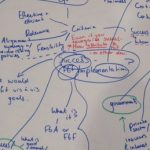The FATHUM Kick-Off meeting was held from July 3rd to July 5th 2017.
Monday 3rd July
 Icebreaker activities and discussion: The FATHUM team had 1-on-1 speed-introductions to each other, trying to find the most interesting / novel thing they had in common. Then they were asked to ‘vote with their feet’, placing themselves in different parts of the room depending on their disciplinary background, applied or theoretical nature of research, and previous history of working with the Red Cross / Red Crescent Movement.
Icebreaker activities and discussion: The FATHUM team had 1-on-1 speed-introductions to each other, trying to find the most interesting / novel thing they had in common. Then they were asked to ‘vote with their feet’, placing themselves in different parts of the room depending on their disciplinary background, applied or theoretical nature of research, and previous history of working with the Red Cross / Red Crescent Movement.
Quiz the Panel: what is Forecast-based Financing? Erin Coughlan de Perez spoke about the history of FbF and why the concept was developed. Irene Amuron spoke about her experience implementing FbF in Uganda. Liz Stephens discussed her view as a scientist advising on the first FbF pilot projects.
Where is Forecast-based Financing now? Erin was quizzed by the group on all the other FbF related activities, including the Dialogue Platform events and the FbF Manual – fbf.drk.de, to which FATHUM research will contribute.
Presentation from Liz Stephens: Introduction FATHUM
Interdisciplinarity Exercise: The team were invited to think about what methods we could adopt as a team to overcome the challenges of interdisciplinary working. We decided on 5 rules to promote interdisciplinary research within FATHUM, along with developing a Glossary of Terms to enable better communication and understanding across our disciplines.
Website exercise: the team were asked for their priorities for the FATHUM website.
FATHUM Advisory Board Meeting: in person & via skype
Tuesday 4th July
Presentation from Hannah Cloke: Work Package 1 Overview Probabilistic Forecasts Game: Andrea Ficchi led small teams through a game to highlight the challenges of decision-making from probabilistic forecasts.
Discussion topic: what is needed from a forecast? Andrea Ficchi asked for different perspectives on the required spatial scale of forecasts.
Impact Activity: Pablo Suarez asked the project team to imagine an important mentor in their life, and what they would tell them about the FATHUM project., then to imagine bumping into a fellow team member in 25 years time; what successes would they like to be reflecting on.
Presentation from Liz Stephens: Project & Impact Deliverables
 Work Package 3 Activity: Sara de Wit led groups organised by discipline in a ‘mapping the conversation’ exercise, discussing “What makes a successful implementation of FbF”, and “What are the barriers to FbF being implemented?”
Work Package 3 Activity: Sara de Wit led groups organised by discipline in a ‘mapping the conversation’ exercise, discussing “What makes a successful implementation of FbF”, and “What are the barriers to FbF being implemented?”
Open Event with other projects from the SHEAR programme and at the University of Reading
Wednesday 5th July
Presentation from Ailsa Holloway: Work Package 2 Overview .
Presentations from Ailsa, Chris and Benedita on the WP2 case studies in South Africa, Uganda and Mozambique. Followed by a fruitful discussion about these case studies.
Presentation from Emily Wilkinson: Work Package 4 Overview. Followed by small group discussions on the how, what and where of upscaling.
Meeting reflections: Erin asked the team for their ‘I like’, ‘I wish’, and ‘I wonder’ feedback on the kick-off meeting. Liz asked for the team to reflect on what they will plan to do ‘on the way home’, ‘in the next month’, and ‘by the next meeting’.
Key Future Activities
*31st August deadline for SHEAR studentship proposals*
*Methodology meeting in Kampala 22nd-26th September 2017*
*Website soon to go live at www.reading.ac.uk/fathum*
*FbF Dialogue Platform meeting in Nairobi in December / January (to be confirmed)*
*Adaptation Futures conference in Cape Town / FATHUM Year 2 meeting in Stellenbosch from June 18th 2018*


 Icebreaker activities and discussion: The FATHUM team had 1-on-1 speed-introductions to each other, trying to find the most interesting / novel thing they had in common. Then they were asked to ‘vote with their feet’, placing themselves in different parts of the room depending on their disciplinary background, applied or theoretical nature of research, and previous history of working with the Red Cross / Red Crescent Movement.
Icebreaker activities and discussion: The FATHUM team had 1-on-1 speed-introductions to each other, trying to find the most interesting / novel thing they had in common. Then they were asked to ‘vote with their feet’, placing themselves in different parts of the room depending on their disciplinary background, applied or theoretical nature of research, and previous history of working with the Red Cross / Red Crescent Movement.
 Work Package 3 Activity: Sara de Wit led groups organised by discipline in a ‘mapping the conversation’ exercise, discussing “What makes a successful implementation of FbF”, and “What are the barriers to FbF being implemented?”
Work Package 3 Activity: Sara de Wit led groups organised by discipline in a ‘mapping the conversation’ exercise, discussing “What makes a successful implementation of FbF”, and “What are the barriers to FbF being implemented?”